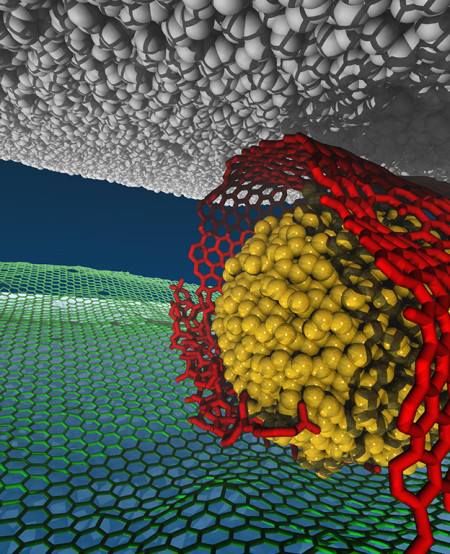Dec
31
Friction Reduction to Near Zero
December 31, 2015 | Leave a Comment
Argonne National Laboratory Center for Nanoscale Materials scientists have built a lubrication system with virtually no friction. Friction hampers the movement of all mechanical parts, including engines for transportation. The new system wraps graphene flakes around nanodiamonds that then roll between a diamond-like carbon-surface and graphene on silica.

Graphic visualization model of a superlubricity (low-friction) system: gold = nanodiamond particles; red = graphene nanoscroll; green = underlying graphene on silica; black = diamond-like carbon surface. Image Credit: Argonne National Laboratory. Click image for the largest view.
Friction hampers the movement of all mechanical parts from engines, motors, etc. in transportation, oil refineries, power plants, and other facilities. The system, like hard ball bearings wrapped in slippery Teflon(R) tissue paper rolling between two surfaces reduces the friction to almost zero.
The new system reduces contact areas and thus reduces friction to near zero. Creating a low-friction situation has the potential for substantial cost savings because friction accounts for most of the energy lost in moving mechanical assemblies and wear accelerates mechanical failures.
The Argonne National Lab team’s paper has been published in the journal Science.
Superlubricity is the state in which the friction between two sliding surfaces is reduced to nearly zero. Friction and wear are the primary modes of mechanical energy dissipation in moving assemblies, thus it is highly desirable to minimize friction in real-world engineering-based applications.
Structural defect issues, however, have stymied the realization of superlubricity. Previous studies have shown the beneficial effect of using graphene to reduce friction. The new study demonstrates that superlubricity can be achieved at the macroscale in a dry environment by the addition of nanodiamonds and graphene flakes between two surfaces, one made of silicon and one made of diamond-like carbon.
In this system, the coefficient of friction is just 0.004, and contact areas are reduced by more than 65%. Analysis of the wear debris revealed that the graphene flakes form nanoscroll-like features wrapping the nanodiamonds. Computer simulations show that more and more graphene flakes scroll with time, gradually reducing the contact area between the nanoscrolls and the diamond-like carbon surface, which allows superlubricity to be attained.
This particular idea has been around for a few months. Having a working system, albeit a lab study, is an improvement. But there is a long way to go. A dry system in say a gasoline or diesel engine would pose a whole list of issues pertaining to heat, scavenging effluent wastes and other significant issues. In engines lubrication does much more than separate moving parts and reduce friction.
But friction is a major problem that converts working energy into waste heat. This team and the others driving the field forward are at the leading edge of one important, if not the most important efficiency problem.

